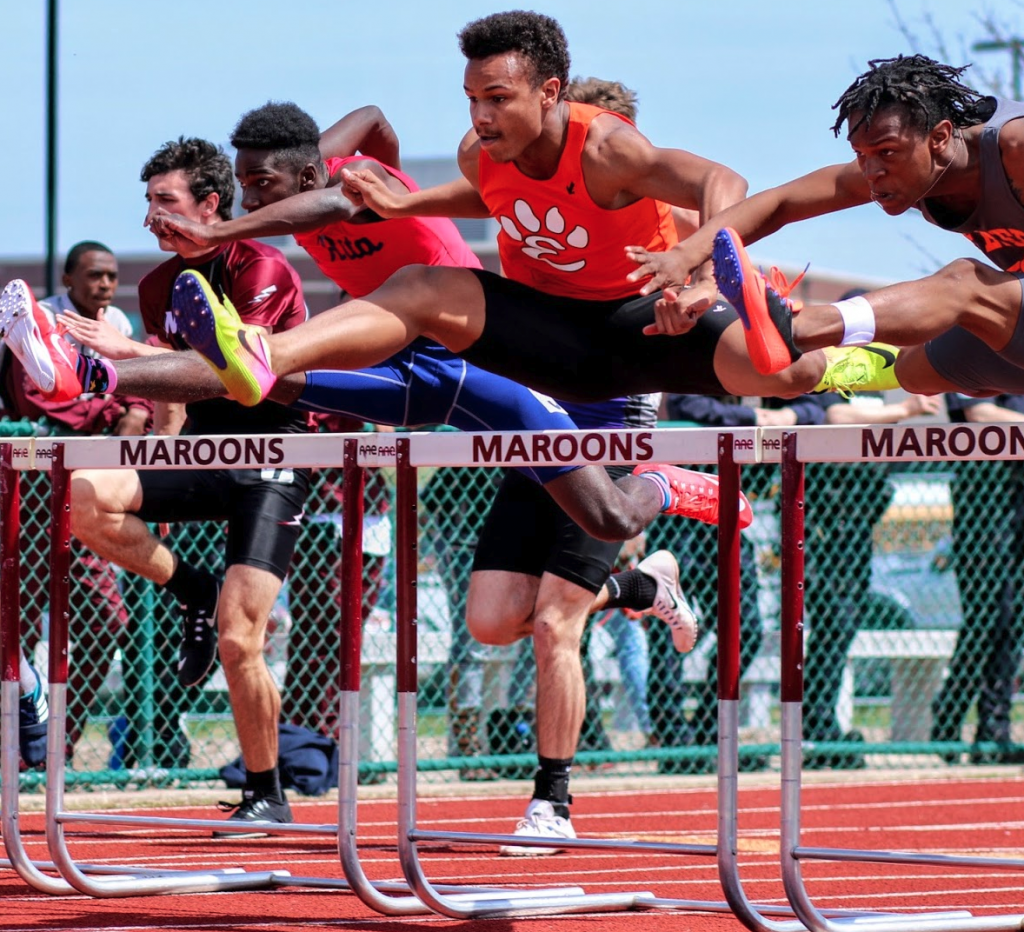
3 REASONS WHY YOUR HURDLER CAN’T 3 STEP
The most common question I get from hurdle coaches…
“Why can’t my hurdler 3 step the whole race?”
“They have the speed but die out by the end. Are they out of shape? Do I need to focus on hurdles 8-10?”
NO!
Your hurdler is fading late because of something that happened earlier in the race.
EVERY HURDLE PROBLEM CAN BE ADDRESSED AND FIXED BY PRACTICING THE FIRST 2 HURDLES.
Hurdlers never fade in the 100/110 hurdles due to exhaustion. It’s not an endurance race. Your hurdler is suffering from an efficiency issue. The efficiency issue is simply more noticeable late in the race. Let’s take a look at what those issues could be.
#1 – TAKING OFF TOO CLOSE TO THE HURDLE
This is very common.
Boo Schexnayder says boys should takeoff from 7’0″ away from the hurdle and girls should take off 6’6″ from the hurdle. It’s common to be too close, rare to be too far.
What happens if your hurdler is too close? Your hurdler will have too much vertical momentum, which leads to a loss in horizontal momentum past the hurdle. The object of the race is to get past the hurdle as quick as possible.
If your hurdler is struggling to maintain efficiency through a hurdle race, put a takeoff mark down. Observe or video takeoff. Even if it’s not exactly the 7’0″ recommended by Boo, you will get an idea what works best for your hurdler.
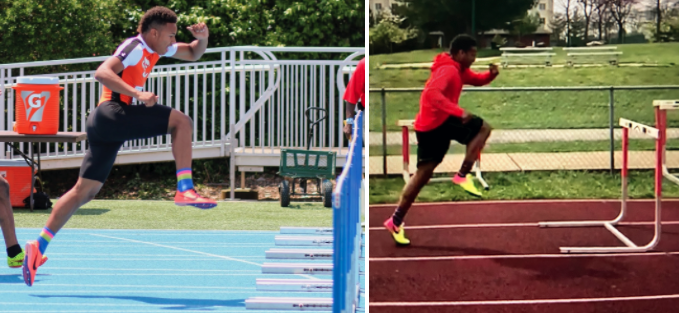
Although there is no mark on the track, we know this is a proper takeoff distance because the hurdler is able to takeoff with his hips displaced and room for lead leg knee extension.
#2 – NOT LANDING ON ONE FOOT
This may confuse some coaches.
“I see my hurdler land lead-leg first every rep… that can’t be it.”
The landing is one of the most under coached aspects of hurdling.
Just because the hurdler lands lead-leg first doesn’t mean the hurdler is landing on one foot. The lead-leg should absorb the entire landing AND bounce off of the ground. Absorb, transition, then generate force in a fraction of a second. Elite hurdlers are great at this.
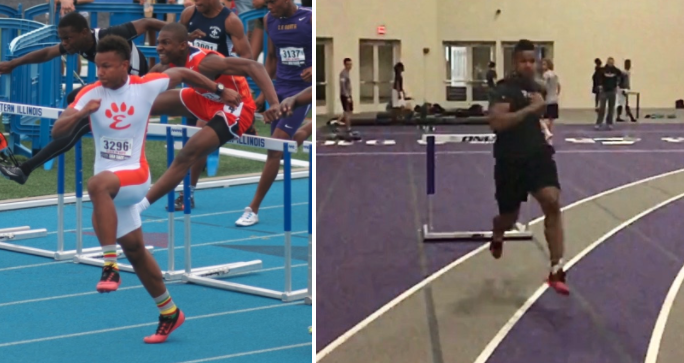
Too often, hurdlers land on their lead leg but continue to fall (or collapse) through the landing of the trail leg or even beyond. Momentarily, they have both feet on the ground. This is easily seen in slo-mo and still frames.
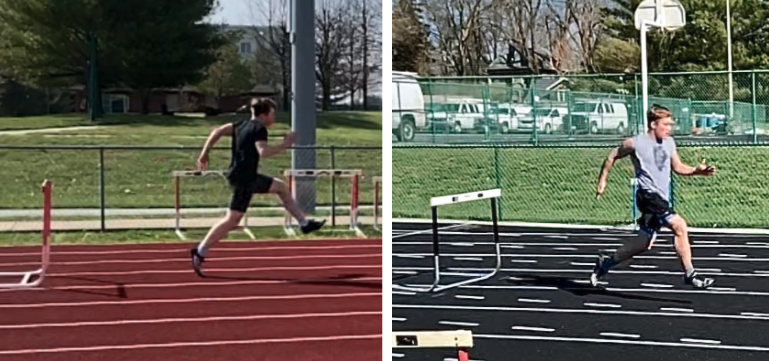
This hurdler shows improvement from the first to the second picture. He struggled with reaching after landing instead of bouncing off the ground, and could not maintain a 3 step. In pic 2, he is airborne and not reaching and is 3 stepping at a high level.
The problem is two-fold. First, your lead leg is failing to maintain forward momentum and minimal ground contact time. Simply stated, your landing is slowing you down. Second, the trail leg is sharing the landing, rather than being utilized as a sprint step.
Due to this loss of momentum, it’s going to be difficult to get to the next hurdle, which leads to the 3rd reason why your hurdler can’t 3 step…
#3 – REACHING
It is common for a panicked hurdler to take longer steps to try to cover more ground.
To get to the next hurdle, longer steps may seem effective. However, in the long run, each additional hurdle will be more difficult to reach.
Simply stated, longer steps will slow you down. High speed sprinting requires VERTICAL FORCE. Heel-first landing results in long ground contact times. Elite sprinters spend very little time on the ground… an astonishing .08 seconds. The reach results in a “braking” action, like pushing the brake pedal in a car. Forward momentum is compromised.
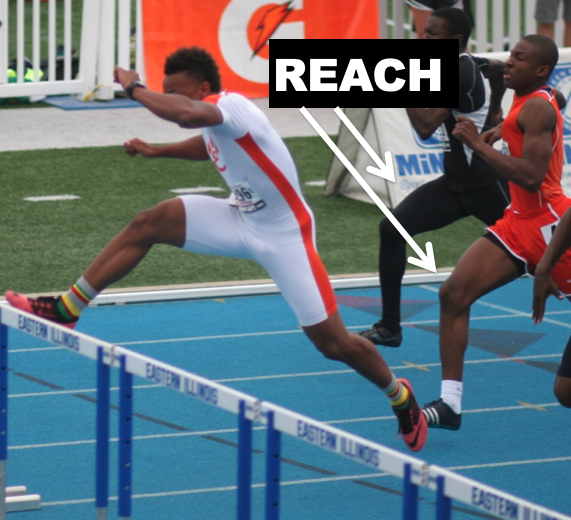
This can happen anywhere in the race. The most common place for a reach is the takeoff step, similar to the takeoff step for a high jumper. The high jumper does it to jump high. Hurdlers should avoid it for the same reason, to avoid jumping high over the hurdle. For a hurdler whose three stepping skill is new or fragile, this can be catastrophic in a hurdle race.
The high jumping hurdler changes horizontal momentum into vertical momentum. The airborne hurdler “floats” high over the hurdle and then suffers an inevitable crash landing. There’s no way to absorb the immense downward momentum, let alone transition it into a bounce.
In hurdling, we want the opposite of a reach: a CUT STEP. A cut step is a step that is “cut short” by landing under the hips on the spike plate with no heel. If done from the proper takeoff distance, the cut step creates a flatter parabola that maintains, or even gains, forward momentum through the hurdle and facilitates a more efficient landing step. The cut step is also essential for proper hurdle form over the top of the hurdle. If you are planting and skying over the hurdle, your arms will fly all over the place trying to keep you safe.
SUMMARY
When you notice your hurdler struggling, you are witnessing the effect. It is your job to look upstream to find the cause. The most common causes are inefficiencies in the takeoff, landing, and stride placement. Start by looking for these issues in the first two hurdles.
by Alec Holler
+++
CoachTube Course: Sprint-Based Hurdling by Alec Holler
Buy the entire FTC Track & Field Bundle with a 51% discount!

Super article. Thank you for an excellent Excellent breakdown—especially the too-close takeoff. This is probably the most common problem I see when helping a hurdler. Once the upward angle of takeoff is increased in that way, the laws of physics keep the hurdler sailing and waiting to return to earth. The late takeoff is usually the best answer to “hanging trail leg.” Thank you for explaining this so well. Another huge problem for three-step hopefuls: they’ve been taught four-stepping to win middle school races…some carry something like a lead leg dyslexia into high school. Keep up the great work, Coach!
I agree 100%! Breaking the bad habits of 4 stepping could be an article all by itself!
Does the take off mark of Boo’s take into account the athletes height difference?